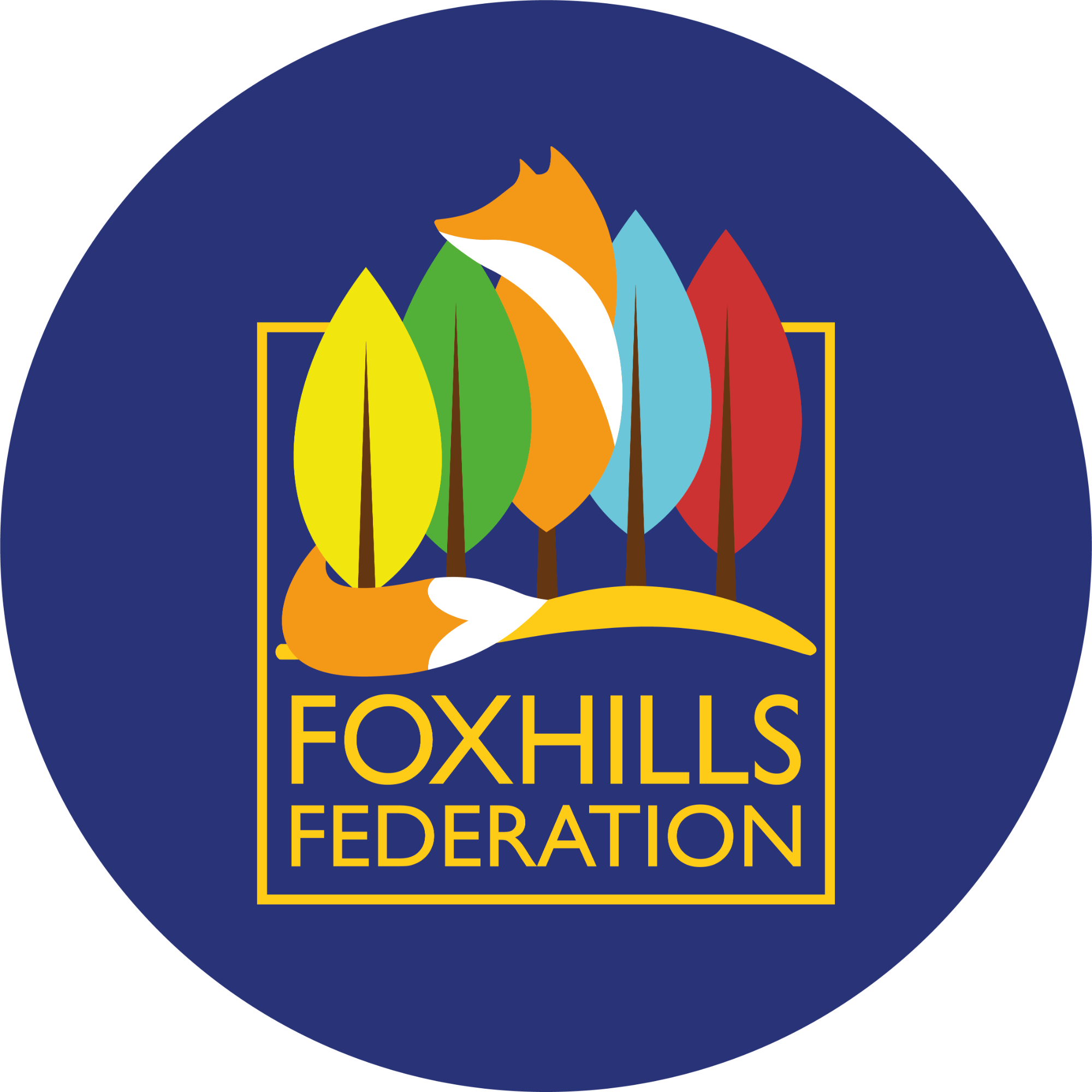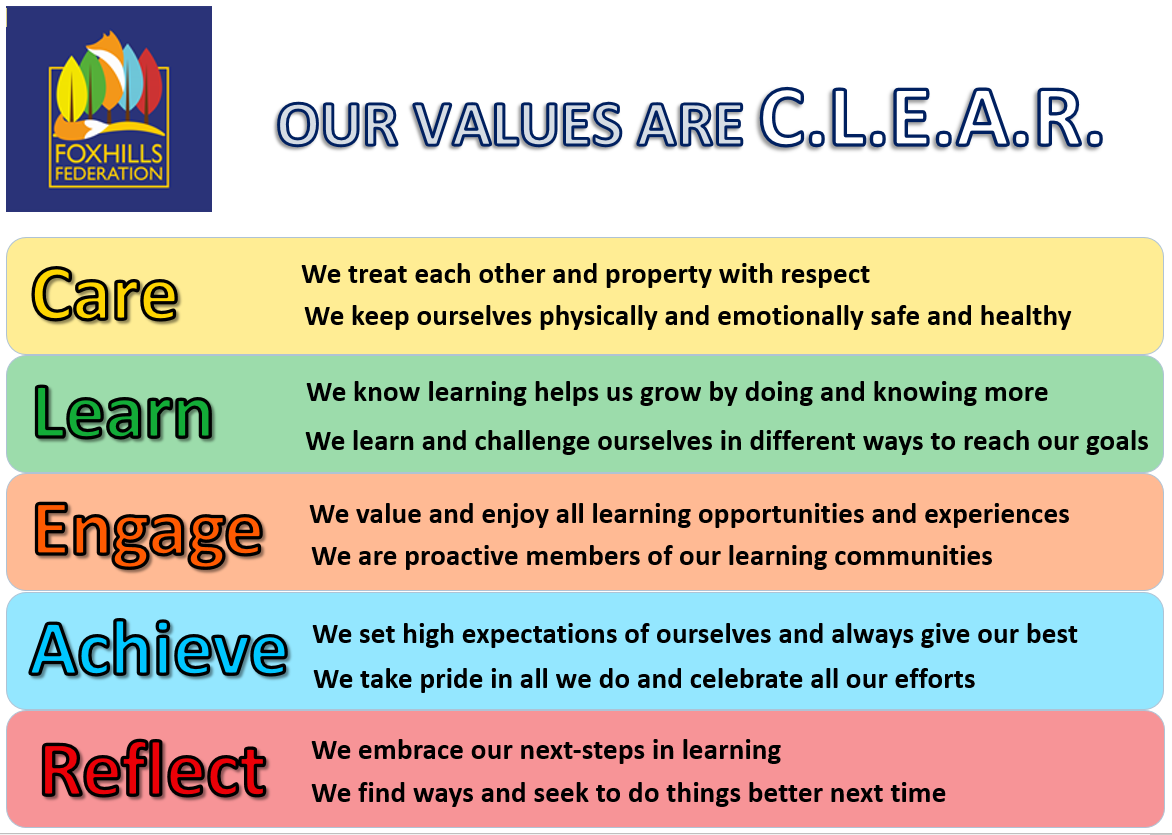Curriculum
Curriculum Intention
Our vision for the Foxhills federation is that all children acquire the knowledge, emotional security and empowerment to enable them to take advantage of opportunities, experiences and responsibilities in later life (so they are prepared and can be aspirational for their future).
We prioritise these areas because:
- Knowledge promotes intellectual growth: The more you know, the more you understand the world. Knowledgeable children are confident, they can broaden their experiences.
- Emotionally secure children are self-aware and can nurture themselves by taking personal responsibility and by building self-resilience essential for challenges and experiences beyond school. Emotionally secure children are self-assured because they are confident about their values and beliefs.
- We want children to be forward-thinking by the time they leave our federation, with an ability to cherish traditional core values of respect, tolerance and kindness which promote empathy. An ability to relate to others ensures children can be active members of social groups in school and beyond, which enables them to be positive influencers in their community. When empowered with purpose and direction (as a result of the above), children will be ready for the next stage of education and life.
Crucial to achieving our vision has been the co-construction (the consensus between leaders and teachers over what children need) of a C.L.E.A.R clear set of learning values which shape attitudes and behaviours and underpin the ethos, curriculum and pedagogy of the federation.
Our C.L.E.A.R curriculum drivers are:
Our curriculum is coherently planned and sequenced towards cumulatively sufficient knowledge and skills for future learning because we have identified:
- A set of concepts (in KS1) and knowledge links (in KS2) in each subject so the discipline of each subject is clear.
- The ‘crucial knowledge’ within each subject: the knowledge all children must acquire.
- How knowledge is applied as a skill- which is used to inform task design.
- The characteristics of learning in each subject- so children know how to learn in different subjects
- Key vocabulary- to enable children to connect ideas and strengthen understanding.
Our curriculum is knowledge based because the more you know, the more you can understand the world and broaden experiences. We have a progressive curriculum model because children can only make progress by knowing more, remembering more and being able to do more.
Real life, practical, and first-hand experiences are key features of our curriculum. Knowledge is always given to children in ways they can access to achieve equality and to ensure that no child should have poorer chances or opportunities because of ability or background. Our curriculum has been designed to meet the needs and starting points of our most disadvantaged children, which benefits very child and enables all children to be fully included in all aspects of school life.
Curriculum Implementation
Curriculum Sequencing and Organisation: The sequencing of the curriculum enables knowledge to build. Leaders and teachers have identified the knowledge that will be most useful in supporting children to acquire information in the first instance, and to ensure a quicker and more detailed grasp of subsequent information as it is encountered. The knowledge for each subject is revisited throughout the year to deepen understanding. Supporting children to ‘get better’ comes from regularly revisiting knowledge and applying it in new or different contexts because it aids connecting new information to existing knowledge. Our subject curriculum maps clearly set out what will be taught and when and this enables teachers to see what has come before and what needs to come next: “why this, why now”.
Delivery of Curriculum: Our curriculum is delivered by clear learning pathways known as “learning journeys”. Our learning journeys support children in acquiring, consolidating and using knowledge in different ways, facilitated by the process of ‘Learn, practice and apply’. This process embeds knowledge because children learn new content, practise and revisit in different ways and apply knowledge, in different contexts, within each subject. Assessment is used to systematically check children’s understanding and teaching is adapted in response.
The characteristics of effective learning are identified to support children in understanding the discipline of a subject. This is explained to children as the skills needed to be a…… and when you’re learning in……. you are…… The characteristics of learning are displayed on learning walls and used in lessons to aid thinking and understanding.
Teaching for progression: Within each lesson, knowledge and associated vocabulary are selected for emphasis and thoroughness. Lessons are never in isolation. Learning journeys are used to ensure all lessons fit within a sequence and teachers know what has gone before and what comes next. Learning journeys enable teachers to purposefully position knowledge to build on previous and subsequent teaching - all planning for learning begins with “why this, why now”.
Real life, practical, and first-hand experiences are key features of the school’s curriculum. Knowledge is always given to children in ways they can access to achieve equality, and to ensure that no child should have poorer chances or opportunities because of ability or background.
Curriculum Impact
Our curriculum effectiveness is measured by children remembering more, doing more and knowing more. We measures this in different ways to enable us to evaluate our provision:
- We talk to children about their learning to establish what they remember, what they know and what they can do. This takes place in lessons.
- We design tasks to enable children to apply what they know. These tasks enable us to assess the depths of children’s knowledge and understanding.
- Teachers review children’s learning and subject outcomes through the process of team work scrutiny. This process is used to support subject leaders to determine progression and outcomes in their subject, as well as the strengths and areas for development.
Assessment of our curriculum is considered in three ways:
Assessment Of Learning (summative)
We expect all children to achieve subject specific milestones by the end of each learning project. This information is used to determine the extent that children have learnt key knowledge and skills: it requires the application of a range of components and sub-skills so this type of assessment summarises what children know and can do. It is not diagnostic.
Assessment As Learning
Our research into strategies for effective learning has influenced our choice of using regular, routine-low-stake tasks as part of the learning process. Our curriculum is sequentially mapped to ensure revisiting and retrieval opportunities are available to children because these approaches strengthen children’s memory and enable them to build knowledge webs to connect new knowledge to existing ideas (and schemas).
Assessment For Learning (formative, daily and ongoing)
Formative assessment takes place continuously. It is always timely, focused and precise: feedback is given in lessons and in between via questioning or examining children’s learning. These assessments are used to analyse children’s progress (knowing more and doing more) and this information informs future teaching and learning (the knowledge that needs re-visiting or new knowledge to introduce, the presentation of information and subsequent knowledge and the design of tasks).
Our use of assessment is purposeful, manageable and reliable because we use a range of sources to make our judgements. The impact of our curriculum is measured by:
- Scrutinises of children’s learning (their books, other recorded work)
- Feedback from pupils (pupil conferencing)
- Observations of teaching and learning
- Team work scrutiny

